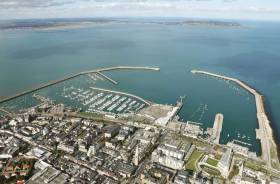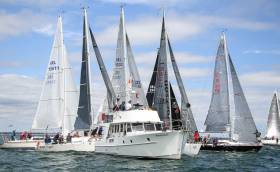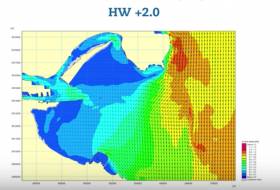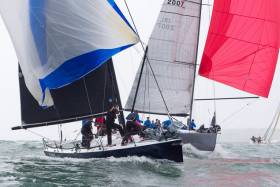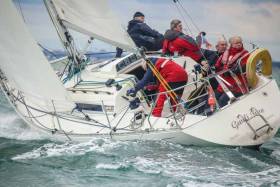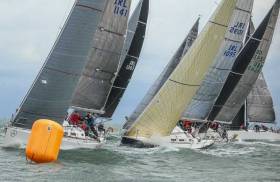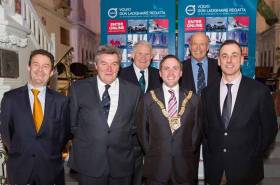Displaying items by tag: Volvo Dun Laoghaire Regatta
The Volvo Dun Laoghaire Regatta has something for everyone at all levels of sailing writes W M Nixon. It’s an event which attracts sailors who have reached the highest levels of international competition ranging through Olympic Medalists and America’s Cup contenders to those who have proven themselves at the very sharpest sharp end of offshore racing.
Yet equally it is the ultimate suburban sailfest for 480 boats (now 500, see here - ed) and their many crews in numerous classes, bringing out the competitive spirit in amiable club sailors who may be competing on Dublin Bay within sight of their home neighbourhood, yet out on the waters of this very special bit of the sea, they become so absorbed in the racing of the day that they could be at some purpose-built venue some hundreds of miles from home.
Regattas are as much about people as boats, and the upcoming VDLR 2019 (it begins next Thursday) has certainly drawn in some noted sailors of extra interest. For instance, Eddie Warden-Owen, the CEO of the Royal Ocean Racing Club, may be best known for his central administrative role in the global offshore racing scene, and before that perhaps his greatest international achievement was in the campaigns whereby he was the guiding light in raising major Italian international campaigns to the highest level.
 The RORC’s CEO Eddie Warden-Owen will be taking part in the Volvo Dun Laoghaire Regatta 2019 in a strictly private capacity – as co-skipper of the 121-year-old Seabird Half Rater Scoter from Treardur Bay SC in Anglesey.
The RORC’s CEO Eddie Warden-Owen will be taking part in the Volvo Dun Laoghaire Regatta 2019 in a strictly private capacity – as co-skipper of the 121-year-old Seabird Half Rater Scoter from Treardur Bay SC in Anglesey.
Yet the RORC’s top administrative honcho has a family home club like many other sailors, and in the case of the Warden-Owen, it is Treardur Bay SC on the Anglesey coast in North Wales. So though the young Warden-Owen may first have emerged at national level as a GP 14 sailor of note, his family’s primary loyalty in Treardur Bay is to the 1898-founded Seabird Class of Half Raters, 20-foot semi-keelboat with centreboards which continue to provide close racing and the right class spirit at Treardur Bay and other centres.
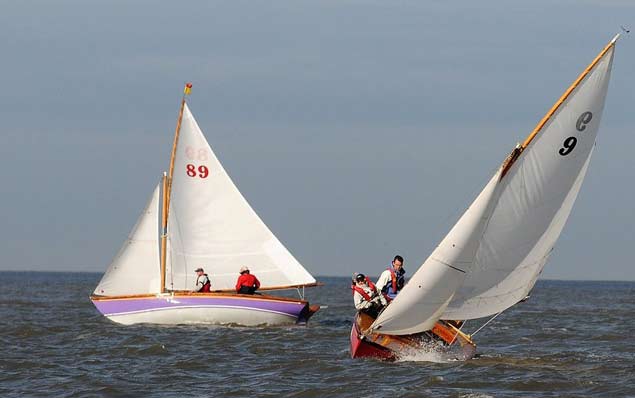 The Seabird Half Raters had their first race on June 8th 1899
The Seabird Half Raters had their first race on June 8th 1899
 The Howth 17s, seen here in a previous VDLR, had their first race on May 4th 1898. Photo: VDLR
The Howth 17s, seen here in a previous VDLR, had their first race on May 4th 1898. Photo: VDLR
North Wales has several such classes, and in recent years with improved road trailerage, they have taken the ferry to Dublin to add their own lively input to Dun Laoghaire Regatta. This time round it’s the turn of Treardur Bay to be the honoured visitors, with its members coming across with their Seabirds and also their 14ft Myth dinghy class.
The Myths are from the time of the club’s foundation around 1920, but the Seabirds go back even further, to Merseyside in 1898-99, and Eddie Warden-Owen and his brother David are custodians of the oldest boat in the visiting flotilla, the 121-year-old Scoter. Thus they will thus be vying for seniority with another classic group taking part at Dun Laoghaire, the Howth 17s from north of the bay whose design and debut afloat pre-dated the advent of the Seabirds by barely a year.
Not all the noted visiting sailors will be in unlikely alliance with boats of ancient vintage, though admittedly the RS Elite keelboats, with their design throwback to the special America’s Cup keelboats of a previous era, may still seem as modern as tomorrow to most Dublin Bay sailors.
In sailing terms, Dublin Bay is one of the most settled communities on the planet. When Dublin Bay sailors find a One Design they like, they tend to stay with it for decades, with years after year of congenial and convenient local sport in a friendly environment in the same boats, a process which is likely to be reinforced by the unexpected longevity of glassfibre craft.
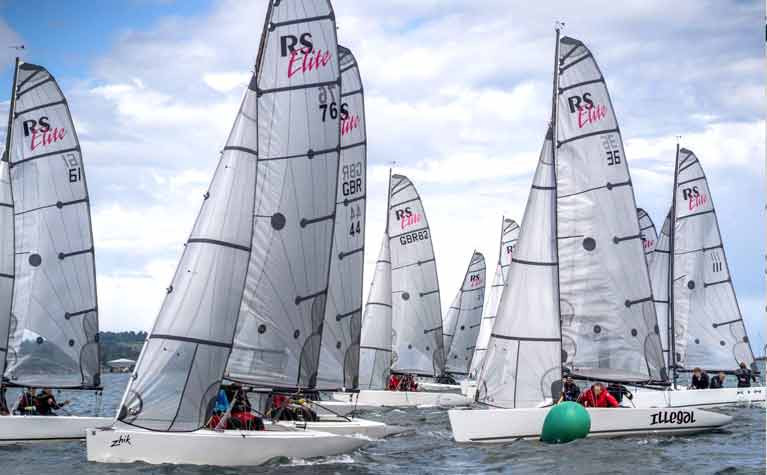 The appearance of the RS Elite is something of an acquired taste……
The appearance of the RS Elite is something of an acquired taste……
 …..but they look better when properly trimmed and going well
…..but they look better when properly trimmed and going well
So the fact that the RS Elites have chosen the VDLR 2019 to incorporate their annual National Championship is a compliment to their hosts and the spirit of the bay, and the class in turn is giving it full top-level support with its contenders including at least two former Olympic medallists – current RS Elite Champion Mike McIntyre who took Gold in the Star Class in 1988, and Ossie Stewart who got bronze in the 1992 Olympiad crewing with Lawrie Smith in the Soling, while for good measure the 34-strong RS Elite lineup also includes current International 14 World Champion Andy Partington and former International Dragon Edinburgh Cup winner Simon Brien from Cultra on Belfast Lough.
 Current RS Elite Champion is Mike McIntyre, Gold Medallist in the Star Class in the 1988 Olympics
Current RS Elite Champion is Mike McIntyre, Gold Medallist in the Star Class in the 1988 Olympics
Our own Olympic Silver Medallist Annalise Murphy is also down for racing in Dun Laoghaire with her International Moth if she can balance it with the current 49erFX campaigning. But once in Dun Laoghaire, the mood can be so relaxing that mid-regatta boat transferences are not unknown, and we might just as likely see our top sailor out on the bay with her mother Cathy McAleavey in one of the latter’s Dublin Bay Water Wags, truly a “Classic of the Classics” with the class’s origins going all the way back to 1887.
This friendly inter-change between varying classes and extremely different boat types hints at something very special in the total sailing environment to be found in the Greater Dublin area, and for locals the VDLR serves a very useful extra purpose in reminding us of just how remarkable is our local sailing.
 Cathy McAleavy racing her Water Wag in the VDLR with her daughter, Olympic Medallist Annalise Murphy. Photo: VDLR
Cathy McAleavy racing her Water Wag in the VDLR with her daughter, Olympic Medallist Annalise Murphy. Photo: VDLR
We have a handsome and vibrant river city, elegantly set in surrounding hills and mountains, and dynamically interacting with a graceful bay. It’s a bay that gives a sense of immediate access to open sea while at the same time providing sufficient sheltered water to promise the ideal location for close-fought racing among a large fleet of boats of many types, with competition at all levels of intensity.
Greater Dublin’s busy population well knows how to make the best use of the diverse sailing opportunities on its doorstep. And for its notably affluent population in the conurbation’s extensive hill-girt southern sector, virtually all of the remarkable maritime energy is focused through one sailing port, the large and classically-inspired artificial harbour of Dun Laoghaire with its four highly-individualistic and undoubtedly stylish yacht clubs, whose historic style is balanced by the most convenient of quayside facilities supported by an extensive marina.
So many factors combine in making the Volvo Dun Laoghaire Regatta the largest sailing event in Ireland that in the end whether it’s a success or an outstanding success comes down to the one element over which the organisers have no control: the weather.
 Gentle summer weather, vintage clipper bows – the distinctive stem profiles of Myfanwy (built 1897) and Peggy Bawn (built 1894) at the VDLR 2017. Photo: W M Nixon
Gentle summer weather, vintage clipper bows – the distinctive stem profiles of Myfanwy (built 1897) and Peggy Bawn (built 1894) at the VDLR 2017. Photo: W M Nixon
Last time round in 2017, summer was settled comfortably on Dun Laoghaire, with balmy almost windless evenings, yet each day brought more than enough wind to see the programme satisfactorily completed, while keeping things gentle enough such that many classes – particularly those in the classics and traditional divisions - could finish with considerable style within the harbour.
But then, 2017 marked the Bicentenary of this remarkable structure, which has been so solidly built of local granite that it now seems to be a natural part of the landscape. Nevertheless the memories and sentiments of the Bicentenary have been incorporated into the way we think about this very special regatta with its unique purpose-designed format, which only finally emerged in 2005 after several attempts over several decades to provide Dun Laoghaire with a flagship event which matched the significance of the Harbour’s role in local, national and international sailing.
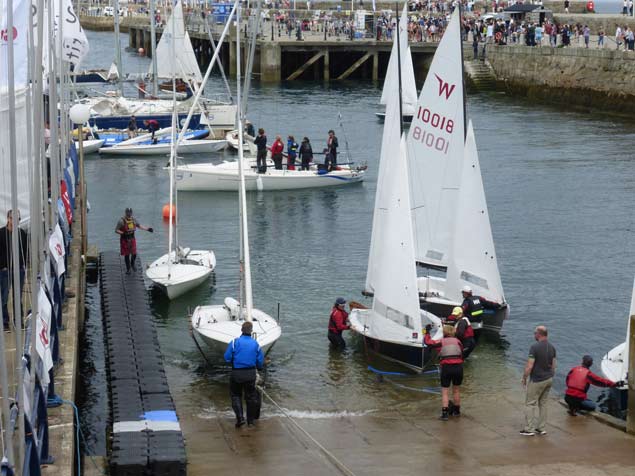 A 200-year-old harbour responds to contemporary needs – retrieval time for Flying Fifteens and Wayfarers at the National YC during the VDLR 2017. Photo: W M Nixon
A 200-year-old harbour responds to contemporary needs – retrieval time for Flying Fifteens and Wayfarers at the National YC during the VDLR 2017. Photo: W M Nixon
But while the basic programme of four days of racing beginning on Thursday afternoon and concluding with a boisterous prize-giving on the Sunday afternoon has been successfully maintained, each time round the Organising Committee incorporates lessons learned from each staging. And they add useful innovations too, for the Dublin Bay sailing setup is such that Don O’Dowd, the current Chairman, and his Organising Committee find like their predecessors that their “clients” are so passionate about the sport in their bay that they are definitely not backwards in coming forward with suggestions for their own notions of regatta improvement.
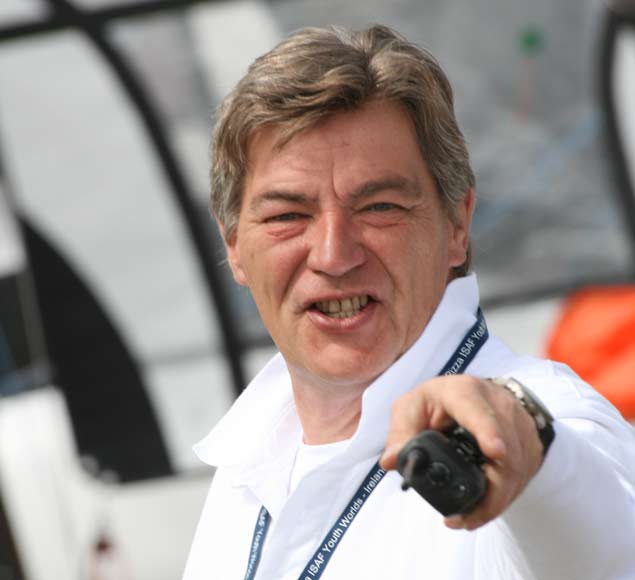 Don O’Dowd, Regatta Chairman
Don O’Dowd, Regatta Chairman
All in all, it’s an extraordinary logistical challenge, with 450 boats and at least 24 separate classes, with the actual number depending on how you define “class”. There’s everything from top-level IRC racers through a colourful variety of One Designs and on to traditional and classic boats of such vintage that it’s a brave pundit who would say just how old they are.
As for the actual sailing, it can vary from a crowded daily programme with top-standard races back-to-back, through just one gentle race for special boats, while the IRC fleet have the added option of joining a division with just one coastal race per day which better allows them to spread their wings, and for 2019’s Regatta, the coastal racers will include George Sisk’s Xp44 WOW (RIYC) fresh from victory in the coastal division at the Sovereign’s Cup in Kinsale, Dingle race winner Paul O’Higgins’ JPK 1080 Rockabill VI, former Sailor of the Year Conor Fogerty’s new foiling Benetau Figaro 3 Raw from Howth on the countdown to the Fastnet Race on August 3rd, and current ISORA Champion, the J/109 Mojito (Peter Dunlop & Vicky Cox, Pwllheli SC).
This means that Mojito will not be in face-to-face competition with the increasing Irish J/109 fleet, which reached a fresh height of competitiveness at the Sovereign’s, with the new boys on the block for 2019, Richard Colwell and Johnny Murphy’s Outrajeous, looking good for honours with Mark Mansfield – who was on the strength in the successful campaign in Kinsale – back on board for the Battle in the Bay.
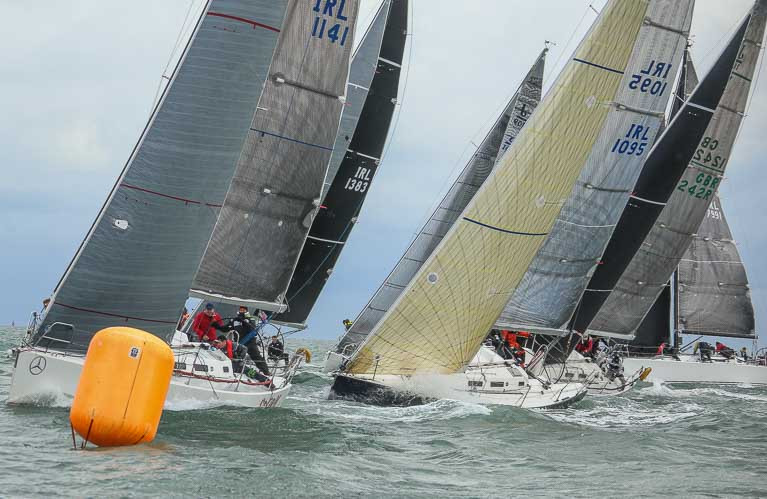 J/109s in close contention in Dublin Bay. This classic American design fits well with the Dublin Bay One Design tradition. Photo: Afloat.ie
J/109s in close contention in Dublin Bay. This classic American design fits well with the Dublin Bay One Design tradition. Photo: Afloat.ie
Not all the top J/109s were at Kinsale, and current 2019 Champion, the Goodbody family’s White Mischief (RIYC), is hotly tipped for success sailing on waters in which pater familias Tim Goodbody has achieved more major wins than anyone can remember in several different types of very competitive One Designs. Meanwhile, a former Irish champion J/109, Pat Kelly’s Storm of Howth and Rush SC, has beefed up her crew strength for Dun Laoghaire with the addition of sailmaker Nigel Young.
The J/109s in their current hyper-tuned state are more than enough for most of us to be contemplating, but a further ingredient is added to the mix with the presence of the newly re-crowned RC35 champion, the First 36.7 Animal from Scotland (Debbie Aitken), so for those with a mind to concentrate on the results of just one class, the J/109s have enough to be going on with.
But to take such an approach is not in the spirit of the regatta, and the reality is that if we go down the IRC Divisions, we happen upon the classic Half Tonners, miracles of restoration mostly based in Howth which in 2019’s hugely intense early season raised their racing bar even higher.
Currently, the pacesetter is Mata (Michael & Darren Wright and Rik De Neve, HYC), which a year ago was a somewhat tired old warrior which seemed to have her best years behind her. But the Wright team took her over and with crew boss Sam O’Byrne co-ordinating a meticulous re-birth in Alan Power’s renowned “laboratory” in Malahide, Mata was ready for the Scottish Series at the end of May where she gave her first indication of things to come as runner-up to clubmate Jonny Swann’s Harmony. Then she was in the groove in the ICRA Nationals to win, and by the time the Half Tonners were joined in really serious group battle at Kinsale, it was Mata which won the Half-Ton Nationals incorporated in the series, and for Dun Laoghaire, her crew-of-all-the-talents continues to include sailmaker Shane Hughes.
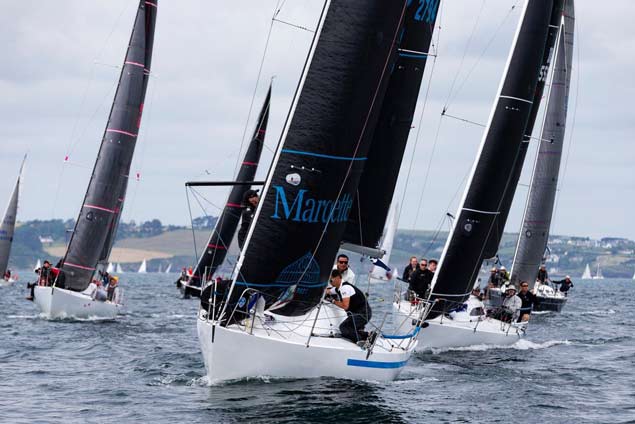 The Half Tonner Mata winning in Kinsale. Only a year ago, she was a tired old warhorse, but a major revival programme has worked wonders
The Half Tonner Mata winning in Kinsale. Only a year ago, she was a tired old warhorse, but a major revival programme has worked wonders
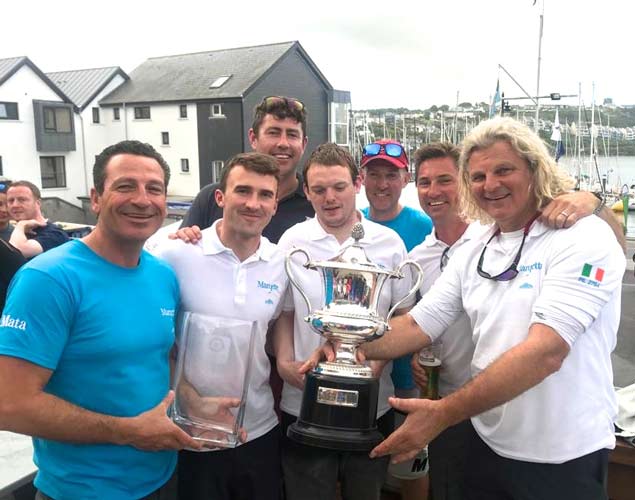 These are the boys to beat – the Mata crew in Kinsale with the Irish Half-Ton Champions trophy are (left to right) Darren Wright (helm), Sam O’Byrne (mainsheet), Killian Collins (tactics), Ciaran White, Shane Hughes of North Sails, Rick De Neve, and Michael Wright
These are the boys to beat – the Mata crew in Kinsale with the Irish Half-Ton Champions trophy are (left to right) Darren Wright (helm), Sam O’Byrne (mainsheet), Killian Collins (tactics), Ciaran White, Shane Hughes of North Sails, Rick De Neve, and Michael Wright
Inevitably the location of the sailmaking sorcerers throughout the fleet is always a useful guide to potential performance, and up in the dizzy heights of Class 0, the word is that Maurice Prof O’Connell will be back with Crosshaven’s Conor Phelan on the Ker 36 Jump Juice to see if they can topple Frank Whelan of Greystones from the remarkable dominance he showed in Kinsale to win the Sovereign’s Cup with a clean sweep of wins right down the line with the Grand Soleil 44 Eleuthera.
Another element in Class 0 is the regular and competitive presence of Jay Colville’s First 40 Forty Licks from East Down YC in Strangford Lough, while there’s a new presence to be factored in with the re-appearance of Jamie McWilliam of the Royal Hong Kong YC with his Ker Fast Forty Signal 8, and the turnout in Class 0 has another twist with the appearance of Scotland’s Jonathan Anderson with the J/122 El Gran Senor.
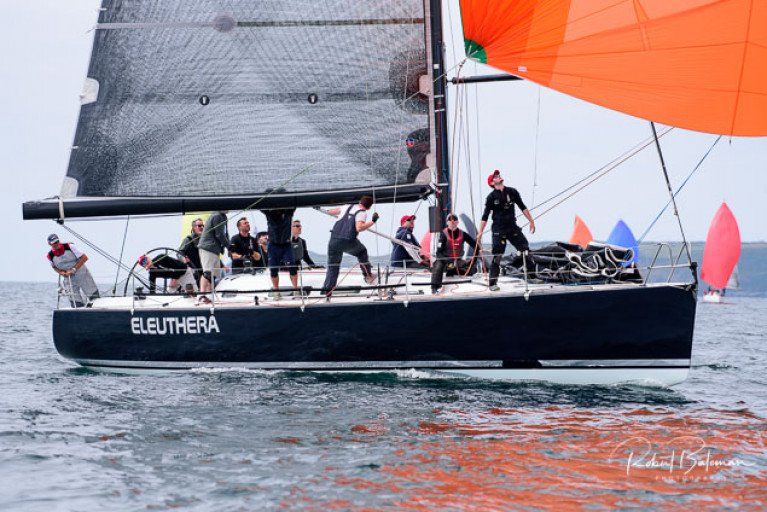 Another of the “Boats to Beat” – Frank Whelan’s Eleuthera from Greystones will arrive in Dublin Bay fresh from a clean sweep in Kinsale. Photo: Robert Bateman
Another of the “Boats to Beat” – Frank Whelan’s Eleuthera from Greystones will arrive in Dublin Bay fresh from a clean sweep in Kinsale. Photo: Robert Bateman
After considering the various rating permutations which come as part of the deal with IRC classes, it’s like a breath of fresh air to turn to the extensive One Design dinghy and keelboat presence, but even here the twenty or so classes which will be receiving their own starting signal present a bewildering variety of types, though one thing is clear – the visit of the RS Elites means that with 34 boats, they’re the most numerous keelboat OD class, toppling the Flying Fifteens with their 23 boats for 2019 from their usual dominant position, while it has to be said that the Sigma 33s, celebrating their 40th Anniversary, are putting in an excellent show with 20 boats all determined to make life difficult for current champion Rupert (Dick & Philip Lovegrove, RStGYC).
Another good turnout is the 15 boats being achieved by the J/80 Class, which has proven to be particularly suited to Irish requirements. The impact of the J/80 may be relatively new, but we cannot help but notice that one of the favoured helms in the class next week has to be Robert Dix, yet another product of the remarkable sailing nursery which is Malahide.
His continuing sailing skill prompts us to remind the Royal Cork YC that at their Quarter Millenial Celebrations in 1970, one Robert Dix at age 17 emerged as the youngest-ever winner of the Helmsman’s Championship of Ireland. With the RCYC Tricentenary coming up next year, the Golden Jubilee of Dixie’s success is surely something which will get a special mention.
With many of the One Designs - dinghies and keelboats alike - it’s national and world championships coming down the line which are shaping their thinking. The Flying Fifteens are well into the countdown for their 2019 Worlds at the National YC in September, while the GP14 Worlds are in Skerries next year, and they have their Irish nationals at that venue next month. Meanwhile, the VDLR 2019 is also their Leinster Championship, and a fleet of 34 makes them the biggest dinghy class, notable among them being new GP 14 sailor Alex Barry of Monkstown Bay on Cork Harbour, whose early successes this year point towards an interesting trajectory towards the Worlds.
 The GP 14 Munsters at Cullaun in May, when Alex Barry of Monkstown Bay and Richard Leonard made a successful debut with the class. They will be racing with a large class of GP 14s in the VDLR 2019 in what will also be the Leinster Championship. Photo: Rachel Thunder
The GP 14 Munsters at Cullaun in May, when Alex Barry of Monkstown Bay and Richard Leonard made a successful debut with the class. They will be racing with a large class of GP 14s in the VDLR 2019 in what will also be the Leinster Championship. Photo: Rachel Thunder
The introduction of a Classics & Traditional Division in the VDLR 2017 as a special for the Harbour Bicentenary worked so well two years ago that it’s a feature which has been retained, and of course if we add in the older One Designs which consider themselves race boats first and classics as a bonus, boats like the Seabirds, the Howth 17s, the Water Wags, the Mermaids and the Myths, there is actually a quite substantial Classics Regatta to be discerned within the larger picture.
There’s a substantial and varied entry in place. The huge numbers of volunteers are quietly working themselves into their vital roles. The flotilla of committee boats have been vigilantly checked for smooth functioning. And the structures – administrative and physical alike – are taking their final shape ashore. So now, with summer having firmly shown itself to be here or hereabouts – albeit somewhat unevenly - in recent weeks, what are the wind and weather prospects?
As the man said, forecasting is so difficult because it involves predicting the future…..We’re supposed to have access to reliable ten day forecasts these days, but 2019 has already shown that this is a mistaken assumption. At the time of writing, the Jetstream is to the north of us. Let us hope it stays there, yet leaves enough energy to provide a decent sailing breeze each day, but not too much…..
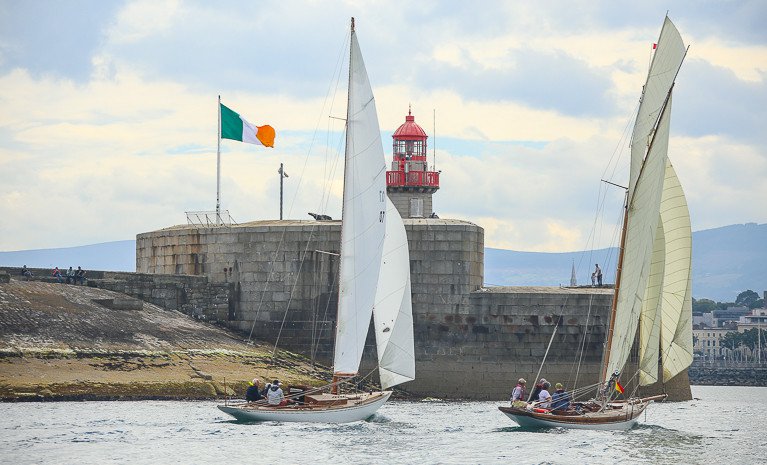 The enduring image of the Volvo Dun Laoghaire Regatta 2017 – in a warm summer breeze, the Dublin Bay 24 Periwinkle and the 1897 Alexander Richardson cutter Myfanwy race neck and neck for their in-harbour finish. Photo: Afloat.ie/David O’Brien
The enduring image of the Volvo Dun Laoghaire Regatta 2017 – in a warm summer breeze, the Dublin Bay 24 Periwinkle and the 1897 Alexander Richardson cutter Myfanwy race neck and neck for their in-harbour finish. Photo: Afloat.ie/David O’Brien
Mermaids Back in Dublin Bay for VDLR 2017
The 2017 Volvo Dun Laoghaire Regatta saw the return of the Mermaid fleet in impressive numbers to Dublin Bay for the first time in a number of years. 15 Mermaids took part in what was also their Leinster Championship from the 6th to the 9th of July. With their race area at the Salthill mark the first day and South Bull for the remaining 3 days of racing, the fleet got all 10 races in for what proved to be an exceptionally competitive fleet. The leaderboard changed constantly with 3 different boats lying at the top spot after the first three days of racing. Local boat 134 Jill helmed by Paul Smith with his crew Anne Smith and Pat Mangan were leading following the first 2 races on day 1 but this quickly changed following another 3 races on day 2 where Foynes boat, 188 Innocence helmed by Darragh Mc Cormack then found himself in the lead. The 3rd day of racing, again with 3 races, saw the leaderboard move again after Skerries boat 186 Gentoo helmed by Brian McNally played a blinder with a second and 2 firsts that moved him up to first place overall. Ultimately with the lowest points and most consistency across the entire regatta (in what was extremely close racing), the winner was 134 Jill from the Royal Irish Yacht Club.
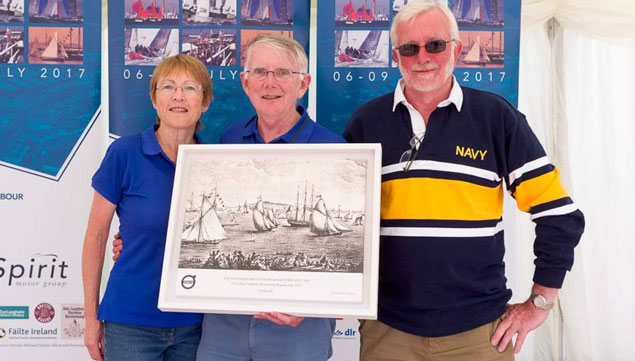 Mermaid winners – Number 134, Jill, from the Royal Irish Yacht Club, (from left to right Anne Smith, Paul Smith and Pat Mangan). The trio are now also the new Leinster Champions Photo: Gareth Craig
Mermaid winners – Number 134, Jill, from the Royal Irish Yacht Club, (from left to right Anne Smith, Paul Smith and Pat Mangan). The trio are now also the new Leinster Champions Photo: Gareth Craig
The Mermaid fleet are used to, for the most part, having Olympic courses all to themselves so sharing with up to 5 other fleets using a mix of inner and outer trapezoids meant the fleet were kept very much on their toes but they stepped up to the challenge! Mostly light winds dominated the majority of the racing and having the local knowledge of the Dublin Bay tides definitely proved an advantage. Having to account for a lot of other boats on the course saw new tactics come into play and those who could use this to their advantage gained big leads (often at the expense of others!). After the racing, entertainment, “the best pints of Guinness ever” and great BBQ food kept the majority of the Mermaid competitors enjoying the social side of things as they are so well known to do.
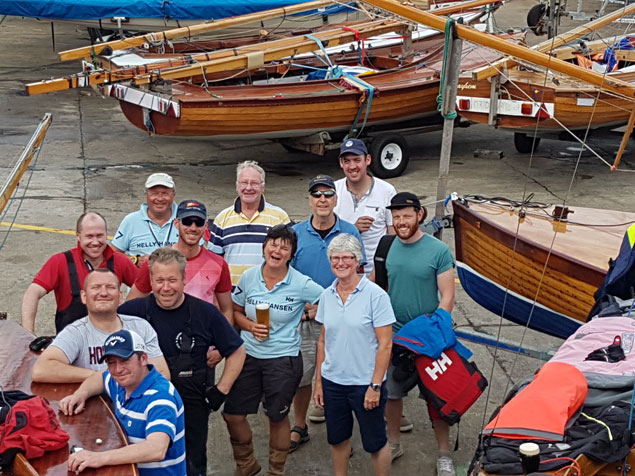 Back to their historical roots of Dublin Bay – Mermaiders in apres-sail mode after a successful VDLR and Leinster Championships at the National Yacht Club
Back to their historical roots of Dublin Bay – Mermaiders in apres-sail mode after a successful VDLR and Leinster Championships at the National Yacht Club
Hosted by the National Yacht Club it was a great return of the fleet to it’s historical roots of Dublin Bay and the consensus from the fleet overall was that it was a fantastic event blessed with great racing, weather, company and entertainment. A big congratulations to the organisers of the Volvo Dun Laoghaire regatta and all 4 clubs of Dublin Bay for what was a brilliant 4 days. The Mermaids are now keen to ensure their next visit won’t take so long!
A big congratulations to the winner 134 Jill now also the 2017 Mermaid Leinster Champion. With hardly time to have their gear washed and dried, the fleet are heading North to Skerries for their annual Regatta this weekend. With their main National Championship event being hosted at Skerries Sailing Club this year from the 5th to the 11th of August, the Regatta is an excellent opportunity for competitors to have a practice run, get to know the race area and get their boats tuned up for the main event, watch this space!
Read more about Dun Laoghaire Regatta 2017 in one handy link here.
Dun Laoghaire Regatta 2017 Photo Gallery
Ireland’s biggest sailing event, the Volvo Dun Laoghaire Regatta, had an exciting four days of racing in Dublin Bay with over 475 boats and almost 2,500 sailors competing. Here's a selection of images in the gallery below:
Full Moon will Play Role in Dun Laoghaire Regatta 2017
With light to moderate breezes anticipated for much of this year’s Volvo Dun Laoghaire Regatta 2017 which starts tomorrow afternoon, savvy sailors will be cognisant that the Full Moon, which occurs early in the morning of Sunday July 9th, will be playing a role in their activities writes W M Nixon.
A Full Moon means we’re into the rising cycle towards Spring Tides, but fortunately most of the regatta will be taking place in relatively modest tidal ranges. Thus High Water at 1249hrs on Sunday July 9th has risen to just 3.70 metres, and it’s less on all the preceding four days.
However, were the Regatta a fortnight later on July 23rd with the New Moon on Sunday July 23rd, High Water would be pushing towards 4.25 metres, which would certainly make for sporty tides.
But as it is, clued-in competitors will realise that during the progress of this event, tides are going to be that little bit stronger with each succeeding day, and will adapt their tactics accordingly. And in this age of computer analysis of just about everything, Dublin Port Company have produced this very useful live chart of tidal activity in Dublin Bay.
Even if you’re not going racing, it makes for fascinating viewing.
HW Thursday is 1058hrs, Height 3.63 metres. Friday: 1139hrs, 3.66m. Saturday 1200hrs, 3.68m. Sunday 1249hrs, 3.70m.
Next week's Volvo Dun Laoghaire Regatta has 88 IRC entries so far, of which 18 have yet to provide rating certs. Of the remainder, figuring out the handicap breaks to make up five good IRC classes is no easy task. Afloat.ie sticks its neck out to give a best guess on the breaks, numbers and top performers at Ireland's biggest regatta.
A big problem in setting the rating breaks is the lack of larger Class Zero boats and the very large number of Class One boats.
So far there are only five large yachts, rating around 1.100 and higher. Many of the normal class zero yachts seem, for whatever reason (maybe not enough crew, feel they can’t compete in Class Zero or prefer to do longer races), have opted for the Coastal Division. This includes the likes of Wow, Lively Lady, Aurelia, Aqualina. Therefore VDLR organisers will likely need to extend Class Zero to include yachts right down to 1.039 to get the entry numbers in Class Zero up to say, nine. The low number turnout of traditional sized Class Zero boats at this regatta is nothing new, it continues from the very low turnouts of Class Zero boats also at the ICRA Championships (two competed) and the Sovereign's Cup (four competed). As previously mentioned on Afloat.ie, Class Zero in Dublin Bay – and elsewhere – is continuing to dwindle and providing separate class racing for such low numbers is hard for regatta organisers to justify.
The very high number of Class One yachts, including 13 x J109’s will make up a 24–boat fleet from a rating of 1.035 to 1.000.
Splitting Classes Two, Three and Four appear more straight forward, with natural breaks occurring and giving decent numbers in each class.
So here is Afloat.ie's guess on the breaks, numbers and top performers. Bear in mind, the 18 boats with no ratings yet may well change these figures.
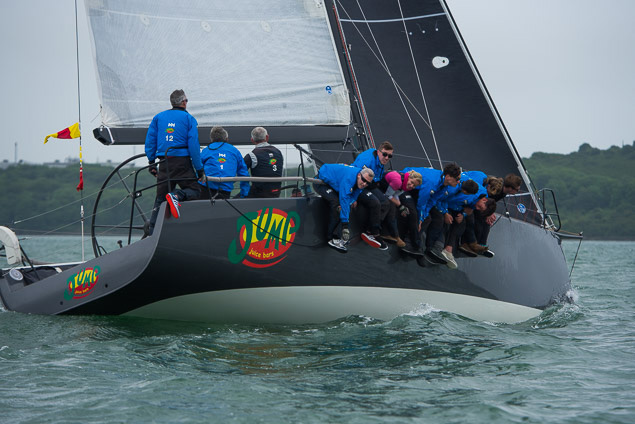 Royal Cork's Ker 39 Jump Juice (Conor Phelan) Photo: Bob Bateman
Royal Cork's Ker 39 Jump Juice (Conor Phelan) Photo: Bob Bateman
Class 0 (rating 1.036 and above—9 entries) Eala of Rhu, a very well sailed Swan 45 from Scotland, won her class at Scottish series, and will be very competitive in this class where she will be out ahead and be able to sail her own race. Behind her are three very similar good boats (Dark Angel, Jump Juice and Aurora (ex Blondie). Dark Angel has had the better of Jump Juice in her last three Regattas and this will likely continue. Aurora will likely be competitive also. Paul O'Higgins Rockabill VI, recent winner of the Dun Laoghaire to Dingle race, if there are strong conditions, will be well to the fore, but in a mixed regatta, expect Eala of Rhu to take it from Dark Angel.
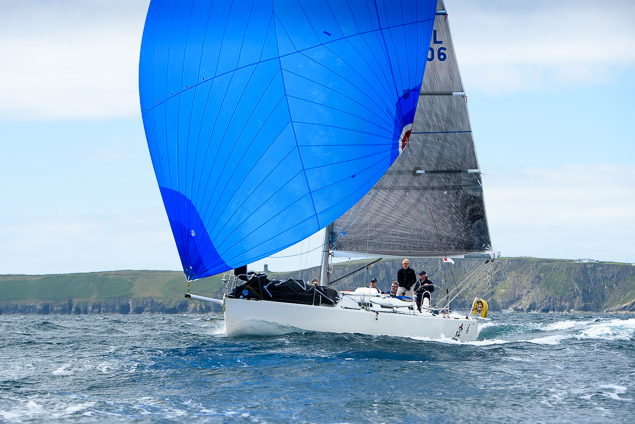 J109 Joker II (John Maybury) – a triple ICRA winner and Tim Goodbody's White Mischief sistership below Photos: Bob Bateman
J109 Joker II (John Maybury) – a triple ICRA winner and Tim Goodbody's White Mischief sistership below Photos: Bob Bateman
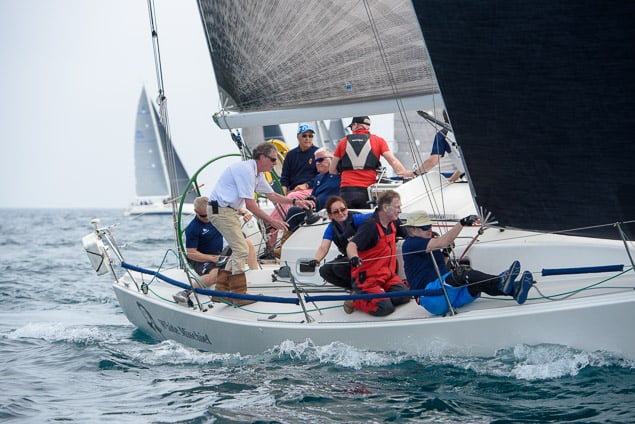
Class 1 (rating 1.035 to 1.000 – 24 entries) This is likely where the best racing will be in the IRC divisions. 13 J 109’s including the three times ICRA National Champion, John Maybury's Joker II. It will be interesting to see how Andrew Algeos Juggerknot and Andrew Craig's Chimera fare against her. Tim Goodbody's White Mischief will also be in the mix. Other notable Dublin entries are Colin Byrne's Bon Exemple and Anthony Fox’s Archambault 35, Gringo. There are a numer of Good Scottish boats of this size and one to watch out for would be Kevin Aitken's Animal which was very competitive in this years Scottish Series. Of course, if Olympian Mark Mansfield is aboard Joker II as tactician, expect it to take it with at least one other J109 on the podium.
 Ross McDonald's ICRA Class Two Champion Equinox, an X332 from Howth Yacht Club Photo: Bob Bateman
Ross McDonald's ICRA Class Two Champion Equinox, an X332 from Howth Yacht Club Photo: Bob Bateman
Class 2 (rating .999 to .959 – 11 entries) This is likely to be a straight shootout between Ross McDonald's X332 Equinox who just won the 2017 ICRA Nationals in Cork and Stephen Quinn's J/97 Lambay Rules which recently won their class at the Scottish Series. If conditions are lighter, we would put our money on Lambay Rules, while if there is breeze, Equinox will be hard to beat. With the present long range forecast of mixed conditions we will just edge it to Lambay Rules.
 Dave Cullen's Checkmate, a Half–Tonner from Howth Yacht Club Photo: Bob Bateman
Dave Cullen's Checkmate, a Half–Tonner from Howth Yacht Club Photo: Bob Bateman
Class 3 (rating .958 to .922 – 10 entries) Likely to be a battle of the Half Tonners, David Cullen's Checkmate V, Johnny Swan’s Harmony, and from Scotland, Roddy Angus’s Trastada. Trastada faired very well at Scottish Series, finishing ahead of Harmony before eventually being beaten by Lambay Rules. If the breeze is strong, expect the X302’s (Maximus, Dux and Xebec) to be to the front but in a mixed wind event we will put our money on Trastada to take it from Checkmate by a nose.
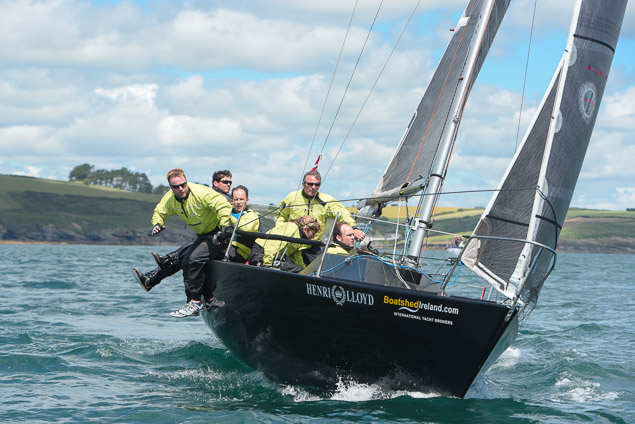 The Quarter Tonner Cartoon (Ken Lawless) Photo: Bob Bateman
The Quarter Tonner Cartoon (Ken Lawless) Photo: Bob Bateman
Class 4 (rating .922 and below –16 entries) A mixed bag including the three quarter tonners, Ken Lawless in Cartoon, Paul Colton’s Cri Cri and Jim Monaghan's Enigma. We would expect the winner to come from these three and with Cartoon finishing ahead of Enigma last week at Sovereign's we will go for Cartoon to win this class. Paul Colton Cri Cri could be a wild card, however, as he has done a lot of work to her over the winter and it is not fully known how this will effect her performance.
The Collen Cup is a new perpetual trophy which has been in the Collen family since 1907 and will be awarded to the overall winner of the Water Wag Class within the Classic section of this and subsequent Volvo Dun Laoghaire Regattas.
The Trophy will be presented by Pamela Collen, on this, the 207th year of the Collen families’ Construction business and on the occasion of the 200th anniversary of the Dun Laoghaire construction commencement.
The Collen Family has had a long association with The Royal Irish Yacht Club. Lyal Collen who married Euphemia Adelaide Falkiner (a daughter of past Commodore Dr. Ninian Falkiner) was an active member throughout his life. The Collen Cup is in honour of Euphemia Adelaide Falkiner, mother of Neil Collen, current Chairman of the firm, who sailed in the Water Wag fleet on Shindilla in the 1950s and 1960s.
Sharing a bicentenary with Dun Laoghaire Harbour, Collen is a main sponsor of the 2017 Volvo Dun Laoghaire Regatta.
With its focus on quality over quantity, next week's Volvo Dun Laoghaire Regatta has grown over 12 years into one of Ireland’s premiere sporting events, let alone sailing – and is now competing with the best in Europe.
If you want a snapshot of the sport of sailing in Ireland, Scotland and Wales in 2017, where would you go? Dun Laoghaire is the answer.
The pages of this year's 2017 Volvo Dun Laoghaire Regatta programme detail over 450 boats in 35 classes, and in so doing they provide the most accurate picture of the Irish Sea sailing scene.
Over four days in July, 300 volunteers will stage 290 races for a mix of cruiser–racers, one-design keelboats and dinghies, plus a unique classics division, all wrapped up in one Irish Sea sail-fest – with Dun Laoghaire as its centre.
In assembling such an armada, Dun Laoghaire Regatta (VDLR) has become, at its seventh staging, not only the country’s biggest sailing event — with over 2,500 sailors competing — but also one of Ireland’s largest participant sporting happenings.
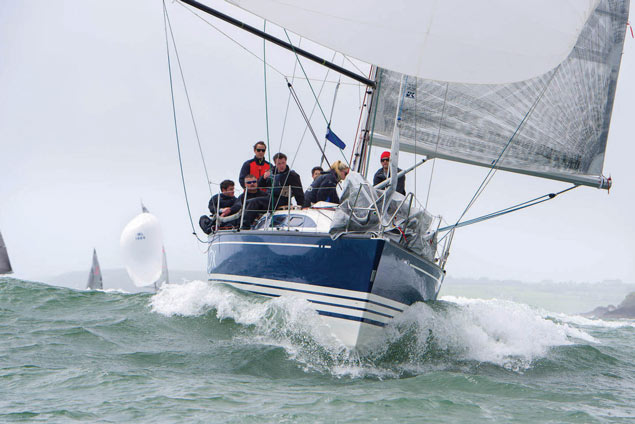 Recently crowned ICRA class two champion, Equinox, skippered by Ross McDonald, is one of 27 entries from Howth Yacht Club. Photo: Bob Bateman
Recently crowned ICRA class two champion, Equinox, skippered by Ross McDonald, is one of 27 entries from Howth Yacht Club. Photo: Bob Bateman
But what’s even more satisfying for the Dun Laoghaire organisers is that nearly half the entries are visiting boats – an indication of the future international prospects of the regatta.
It’s a big achievement for the capital’s waters, given so many other regattas are struggling for numbers.
Focus on quality
‘Never mind the quality, feel the width’ has been a criticism of modern-day regattas where organisers mistakenly focus on being the biggest in an effort to be the best.
And at a time when regatta fleets have collapsed, there is some irony in the fact that Dun Laoghaire, with its own local fleet of 300 boats, never set out to be the biggest yet nevertheless has emerged as the yacht racing hub for the Irish Sea, from the Clyde to Lands End.
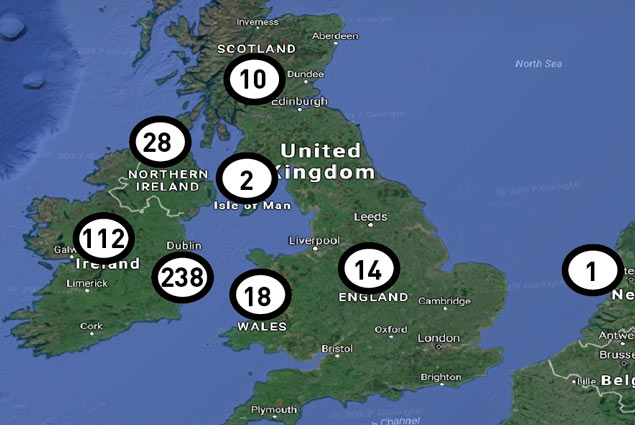 The bulk of entries are Dublin based but the regatta has a growing reach across the Irish Sea
The bulk of entries are Dublin based but the regatta has a growing reach across the Irish Sea
Dublin Bay’s priority focussed instead on quality racing, even after it got off to a spectacularly bad start in 2005 when the event was becalmed for four days.
The idea to rekindle a combined Dublin Bay event had resurfaced after an absence of almost 40 years, mostly because of the persistence of a band of passionate Dun Laoghaire sailors who believed that their home could become the ‘Cowes of the Irish Sea’ if the town and the local clubs worked together.
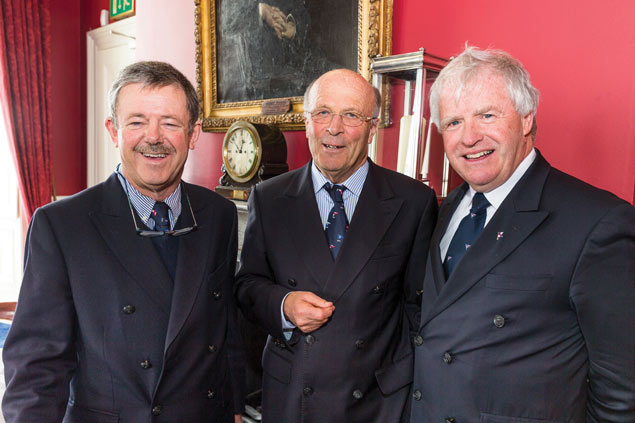 VDLR Beginnings – In 2004, the then Rear Commodores of RStGYC, Owen McNally, (left) RIYC, Timothy Goodbody (centre) and NYC's Ronan Beirne were tasked by the Combined Clubs Committee, chaired by Phil Smith , to submit a proposed format for a combined regatta involving all four waterfront clubs. This they did over a very enjoyable dinner and submitted their proposals which were subsequently adopted by the all four waterfront clubs (Dun Laoghaire Motor Yacht Club, National Yacht Club, Royal Irish Yacht Club and Royal St George Yacht Club, and the inaugural event was chaired by Brian Craig in 2005. Thirteen years on from that, the same, now ex- Rear Commodores, met again to reflect on the development of this great regatta over a very social and enjoyable lunch. Today, the biennial Dun Laoghaire Regatta is a firm fixture on the sailing calendar and run under Dublin Bay Regattas Limited, under the Chairmanship of Dermot Reidy (DMYC).
VDLR Beginnings – In 2004, the then Rear Commodores of RStGYC, Owen McNally, (left) RIYC, Timothy Goodbody (centre) and NYC's Ronan Beirne were tasked by the Combined Clubs Committee, chaired by Phil Smith , to submit a proposed format for a combined regatta involving all four waterfront clubs. This they did over a very enjoyable dinner and submitted their proposals which were subsequently adopted by the all four waterfront clubs (Dun Laoghaire Motor Yacht Club, National Yacht Club, Royal Irish Yacht Club and Royal St George Yacht Club, and the inaugural event was chaired by Brian Craig in 2005. Thirteen years on from that, the same, now ex- Rear Commodores, met again to reflect on the development of this great regatta over a very social and enjoyable lunch. Today, the biennial Dun Laoghaire Regatta is a firm fixture on the sailing calendar and run under Dublin Bay Regattas Limited, under the Chairmanship of Dermot Reidy (DMYC).
Although fickle winds conspired against them in 2005, the support since then from all four Dun Laoghaire waterfront yacht clubs – the Dun Laoghaire Motor YC, National YC, Royal Irish YC and Royal St George YC – in association with the two racing clubs of Dublin Bay SC and Royal Alfred YC, gave them the momentum to carry on.
Numbers peaked in 2007 with over 480 entries, and while that figure remains a record, it is this year’s turnout – matching 2005 – that shows the event is now a confirmed highlight on the British and Irish yachting calendar.
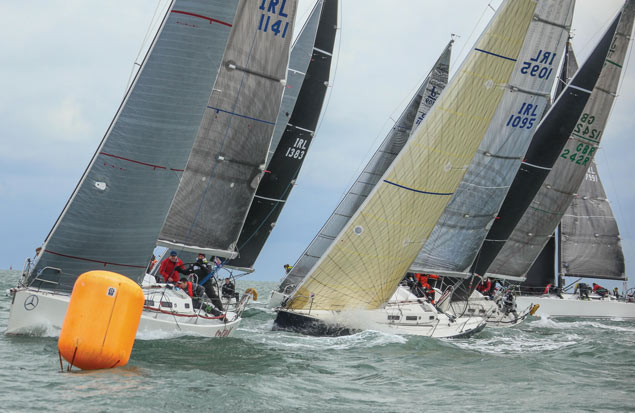 Of the six cruiser classes there is a strong argument that not only is the 27–boat VDLR Cruisers One division the class of the event but it’s also the class of the year. 11 J109s (pictured above) will race as part of the red hot fleet. Photo: Afloat.ie
Of the six cruiser classes there is a strong argument that not only is the 27–boat VDLR Cruisers One division the class of the event but it’s also the class of the year. 11 J109s (pictured above) will race as part of the red hot fleet. Photo: Afloat.ie
Stronger than expected
If success is measured by fleet size, then the VDLR has looked on course for a buoyant seventh edition since April, when half of its massive fleet had already signed up.
More than 2,500 sailors and 800 visitors will race across 35 classes, so outgoing Irish Sailing Association (ISA) President David Lovegrove rightly noted at the regatta launch that it will be one of Ireland’s biggest sporting events when the first gun fires on July 6.
Only once since its inaugural outing in 2005 have numbers dipped below 400, and that was in the teeth of recession in 2013. But even then the fleet only dropped to 393, just 93 lower than 2007’s record year. In 2017 the numbers are tantalisingly close to matching that peak.
 The Dublin Bay Mermaid (above) will have a strong 15–boat turnout. A strong Skerries Sailing Club contingent has swelled the classic clinker fleet that includes national champion Sam Shiels at the helm of number 189 Azeezy
The Dublin Bay Mermaid (above) will have a strong 15–boat turnout. A strong Skerries Sailing Club contingent has swelled the classic clinker fleet that includes national champion Sam Shiels at the helm of number 189 Azeezy
Entries this year are also stronger than expected, as all four Dun Laoghaire clubs bang the drum for the harbour’s bicentenary year.
Well over half of all entries – 60% in fact – come from the locality, with the Royal Irish and National YCs providing half of that number between them.
In keeping with the local celebratory mood, this year a special Kingstown 200 Cup, kindly presented by Dun Laoghaire Harbour Company, will be awarded to the ‘Most Outstanding Classic Boat of Regatta’.
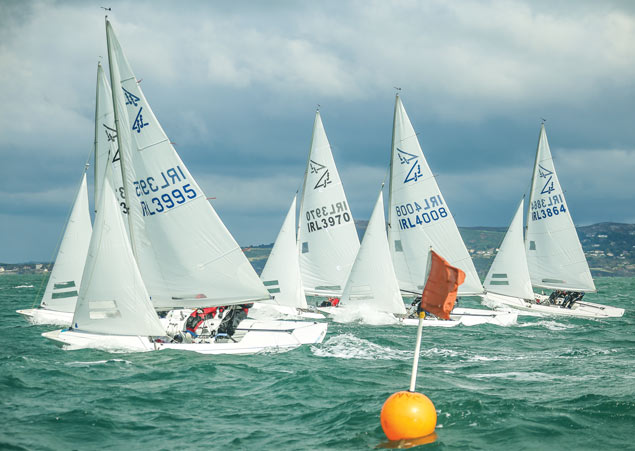 Dublin Bay’s Flying Fifteen fleet has been a mainstay of the regatta since 2005. A 17–boat fleet is entered this year
Dublin Bay’s Flying Fifteen fleet has been a mainstay of the regatta since 2005. A 17–boat fleet is entered this year
Unique facilities
Tim Goodbody, chairman of the VDLR in 2015 and 2017 (and a Cruisers One contender in his own right), believes the regatta owed its prominence in European sailing events to a number of factors.
“One of the reasons it attracts so many entrants is that it is one of the least expensive sailing events in Europe, thanks to generous sponsorship and support,” he said.
Another reason is certainly Dun Laoghaire’s unique facilities. This is the place where the modern rules of sailing were framed over 150 years ago. The Victorians built the best of yachting venues on Dublin’s south shore so that the sailors of today, four generations later, get to enjoy the fruit of their labours.
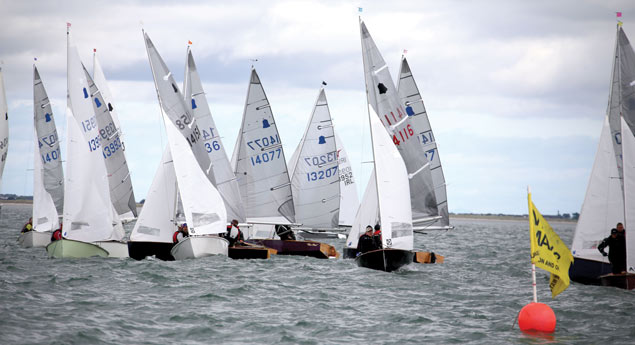 Not only is the 26-boat GP14 fleet one of the largest of the ten competing dinghy classes it also has participation across the country from Moville in Donegal to Youghal in Couty Cork. The boats to watch, of course, in this Leinster Championship fleet will undoubtably be the match between Greystones Sailing Club’s Shane MacCarthy in 14203, the current World Champion and Olympian Ger Owens in 14076. Owens, sailing with Mel Morris, ended MacCarthy’s unbeaten run (on the World Champions) home waters at the Purcell Trophy in May.
Not only is the 26-boat GP14 fleet one of the largest of the ten competing dinghy classes it also has participation across the country from Moville in Donegal to Youghal in Couty Cork. The boats to watch, of course, in this Leinster Championship fleet will undoubtably be the match between Greystones Sailing Club’s Shane MacCarthy in 14203, the current World Champion and Olympian Ger Owens in 14076. Owens, sailing with Mel Morris, ended MacCarthy’s unbeaten run (on the World Champions) home waters at the Purcell Trophy in May.
Dun Laoghaire is a beautiful working and residential seaside town about 12 km (7.5 miles) south of Dublin city centre and 20 km (12 miles) from the Irish capital’s international airport.
Even from mainland Britain, it’s closer than many might think. Sailors from the Ribble, Mersey, Menai Strait, Anglesey, Cardigan Bay and Isle of Man have to travel three times the distance to the Solent as they do to Dublin Bay.
This is one of the major selling points of the Irish event, and explains the range of entries from 69 different clubs around Ireland, including 28 boats from Northern Ireland.
Across the Irish Sea, two boats are coming from the Isle of Man, 18 from Wales, 10 from Scotland and 14 from England. In a nod to organisers that a European market might be worth looking at for 2019, there is a single entry from Holland.
 Dun Laoghaire Harbour's compact site has world class sailing clubs and race areas adjacent to a modern town with a Five Gold Anchor marina of 820 berths at its heart Photo: Michael Chester
Dun Laoghaire Harbour's compact site has world class sailing clubs and race areas adjacent to a modern town with a Five Gold Anchor marina of 820 berths at its heart Photo: Michael Chester
Dun Laoghaire is also unique in sailing terms because there is only a short sail to the race areas from a Five Gold Anchor marina of 820 berths. Rapid transport links, local hotels, bars and restaurants, and four unique clubs positions it as a strong rival to any other European venue
And let’s not forget the social side. The regatta has built up an enviable reputation ashore for exciting live music and entertainment, and this year’s full social programme promises to be no different.
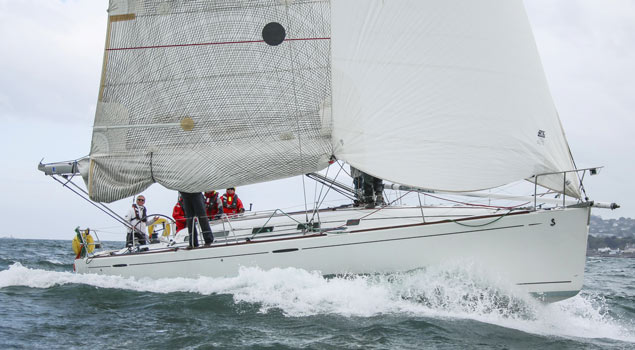 Now firmly established as part of the VDLR mix after its 2015 introduction, the 26-boat offshore class includes many regular ISORA competitors including Derek Martin’s Beneteau 44.7 Lively Lady (pictured) from the Royal Irish Yacht Club
Now firmly established as part of the VDLR mix after its 2015 introduction, the 26-boat offshore class includes many regular ISORA competitors including Derek Martin’s Beneteau 44.7 Lively Lady (pictured) from the Royal Irish Yacht Club
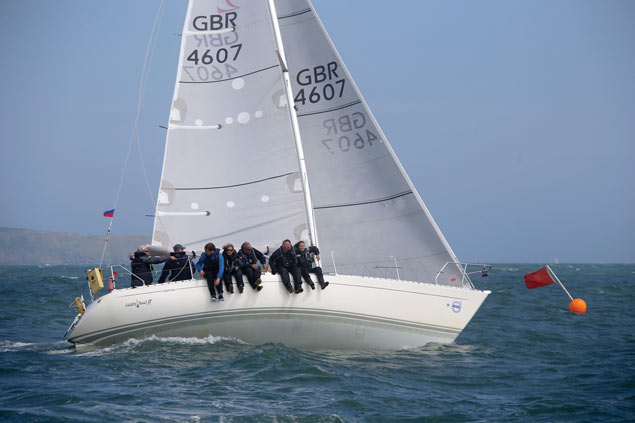 The Sigma 33 is one of the biggest one design cruiser fleets with 20 entries. The long established Dublin Bay class merged with class two for local DBSC racing this year but will hold a special One Design Dun Laoghaire bicentennial Race Day on Friday, 7th July. Pictured is Alan Harper’s Scottish entry Leaky Roof 2 from the Clyde
The Sigma 33 is one of the biggest one design cruiser fleets with 20 entries. The long established Dublin Bay class merged with class two for local DBSC racing this year but will hold a special One Design Dun Laoghaire bicentennial Race Day on Friday, 7th July. Pictured is Alan Harper’s Scottish entry Leaky Roof 2 from the Clyde
Top quality racing
But the action on the water is what it’s all about. From the Baily Lighthouse at the northern entrance to Dublin Bay across to Dalkey Island in the south, there will be seven separate courses laid out for top quality racing.
Indeed, 10 classes have included the regatta as part of their championship calendar in 2017: GP14s, 420s and Mermaid dinghies are racing for Leinster honours, while SB20s, J24s and Squibs will decide East Coast titles, and the Sigma 33s, Beneteau 21s and the Wayfarers will race for national trophies. The vintage Water Wag class will race for a new trophy, The Collen Cup.
 The 15–boat Beneteau 211s are holding the Irish championships as part of VDLR 2017
The 15–boat Beneteau 211s are holding the Irish championships as part of VDLR 2017
Championships running as part of VDLR 2017
Royal Dee Yacht Club Irish Sea Offshore Championship
Irish Sigma 33 National Championship
Irish Wayfarer National Championship
Beneteau 211 Irish Championship
GP14 Leinster Championship
420 Leinster Championship
Mermaid Leinster Championships
SB20 Southern Championships
J24 East Coast Championship
Squib East Coast Championship
Read the entry list class by class starting here
The Sigma 33 may yet be the biggest one design cruiser fleet at July's Volvo Dun Laoghaire Regtta with 16 entries so far.
The long established Dublin Bay class merged with class two for local DBSC racing this year but plans to hold a special One Design Dun Laoghaire bicentennial Race Day during the four day regatta on Friday, 7th July.
Results will be based on all races sailed at the Volvo Dun Laoghaire Regatta on Friday 7th with no discards.
The prize giving will take place in the Royal Irish Yacht Club and includes a Sigma 33 class regatta dinner.
For the summer of 2017 at least, it looks as though Dun Laoghaire Harbour is going to remain free of the threat of the installation of a new liner berth. W M Nixon reckons this provides a unique opportunity for town and harbour to come together as they may have done once upon a time, but have failed to replicate for many years. He provides the background, and makes some suggestions.
The trouble with Dun Laoghaire is that there’s nowhere else quite like it. There isn’t really a truly comparable totally artificial harbour anywhere else on this scale set on the edge of a city, in the midst of an area of general affluence and recreational expectations. It is arguably unique. Nowhere in the world is there a similar setup from which those who hope to manage Dun Laoghaire Harbour effectively might learn lessons on how to make a viable proposition of their port and its future.
Although the original asylum harbour was built by engineer John Rennie and others in majestic style, at the time it had only one simple purpose – to provide shelter for unwieldy sailing ships when Dublin Bay was storm-beset and Dublin Port with its very shallow bar entrance was inaccessible.
The original plans show a sublime indifference to the existence of the little old harbour of Dunleary immediately to the west of the proposed location of the vast new structure. And the little port there has long since disappeared under high value property development to an extent which the early harbour planners cannot have begun to imagine.
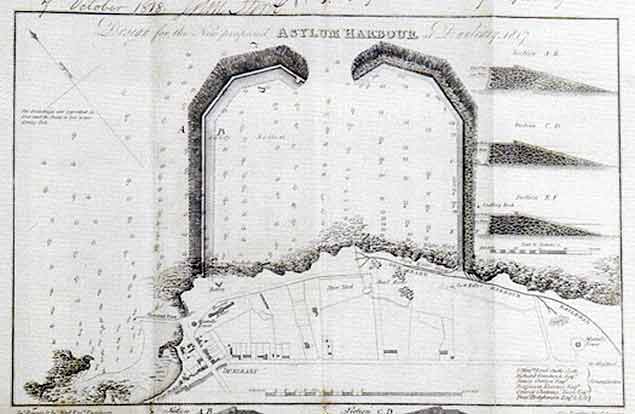 The original plan for the new harbour deliberately excluded the little old harbour of Dunleary to the west, as the new harbour was not intended to provide ship to shore access.
The original plan for the new harbour deliberately excluded the little old harbour of Dunleary to the west, as the new harbour was not intended to provide ship to shore access.
For the idea was not that this would be a port. On the contrary, it would only be a place of temporary shelter in which vessels of importance – particularly those on British government business - would be secure until conditions improved. It was not envisaged that there would be any significant shoreside contact during their short time in what very quickly became Kingstown Harbour.
For of course, no sooner was a harbour under construction, than a town began to develop beside it. It was notoriously un-planned, so much so that fifty years later a critic mocked its name of Kingstown – conferred with a Royal visit in 1821 – by pointing out that far from being a King’s town, it was rather more of a republic of selfish building anarchy.
At the beginning – which we now date to 200 years ago, with the first stone officially laid on May 31st 1817 - significant shoreside development had not been intended. As historian Hal Sisk has pointed out, at no time did the official plans include anything so basic to a proper port town such as warehouses, let alone shipyards or even boatyards. But the basic existence of the harbour in its earliest form by the late 1820s saw the first regatta being staged in 1828. Recreational sailing and the harbour have been intertwined ever since. And the irresistible growth impulse of Kingstown was underlined by the arrival of the railway from Dublin in 1834.
 The eastern part of Kingstown harbour at its Victorian high point as a ferry port. The area in the centre, immediately east of Carlisle Pier, will be used for berthing Classic and Traditional Vessels in July during the Volvo Dun Laoghaire Regatta 2017.
The eastern part of Kingstown harbour at its Victorian high point as a ferry port. The area in the centre, immediately east of Carlisle Pier, will be used for berthing Classic and Traditional Vessels in July during the Volvo Dun Laoghaire Regatta 2017.
We take that date of 1834 for granted, but in terms of world railway history, it was very early indeed. And it in turn roped Kingstown into other unplanned developments. As long as the entrance to Dublin port remained dangerously shallow, Kingstown had all the advantages for the rapid development of the cross channel ferry trade. It was all done initially on an ad hoc basis, but it worked for the ferries, while the already proven attractions of the place as an innovative recreational sailing location made it central to world sailing development by the 1860s and 1870s.
So for most of the two hundred years whose history we’ll be celebrating in July, Dun Laoghaire/Kingtown has been struggling with the fact that the basic concept of the harbour - which by its monumental and historic scale still dictates what can be done with it today – was planned with virtually no attention paid to the sea/land interface.
 Despite the restrictions on waterfront space, Kingstown Harbour had become a leading sailing centre by the latter half of the 19th century, as shown in this painting by Richard Brydges Beechey of a Royal St George YC regatta in the 1870s. Courtesy RStGYC
Despite the restrictions on waterfront space, Kingstown Harbour had become a leading sailing centre by the latter half of the 19th century, as shown in this painting by Richard Brydges Beechey of a Royal St George YC regatta in the 1870s. Courtesy RStGYC
Ideally, when the harbour was being built, at least as large an area ashore should have been set aside on the adjacent land to provide for a proper harbour town. But nothing remotely like this was done, and the railway was brought in by the easiest possible shoreside route, thereby putting another barrier between the growing town and the harbor. As a result, the town/harbour relationship has always been problematic. This is particularly so when allied to the fact that areas of conspicuous affluence are almost cheek by jowl with what seem like semi-deprived areas by comparison.
On top of all this, there’s the eternal problem of paying for the harbour’s maintenance. It was superbly built in the first place, but it would be an insult to those early engineers, and their incredibly industrious workers labouring under dangerous conditions, if we failed to maintain the harbour properly in a manner which respects its original concept, while continuing to give it validity for contemporary life.
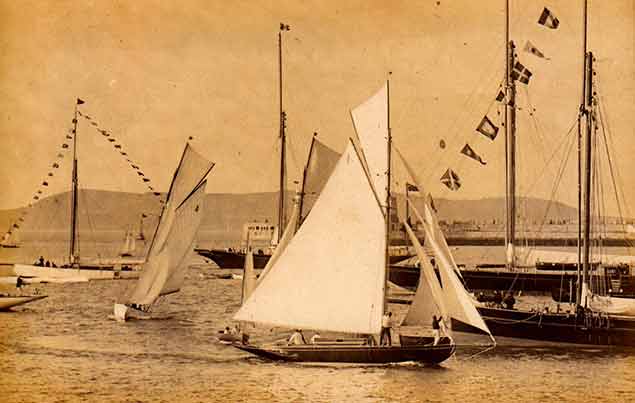 The good old days……..It is the summer of 1901, and the Viceroy Lord Dudley is finishing in-harbour after threading his course through moored yachts to take the win with his new Dublin Bay 25 Fodhla in company with some boats of the new version of the Water Wag class. In second place in the DB 25s is Nepenthe (No 4, Sir H Robinson). Both Dublin Bay 25s were built in Dun Laoghaire by J E Doyle. Photo courtesy Theo Harris
The good old days……..It is the summer of 1901, and the Viceroy Lord Dudley is finishing in-harbour after threading his course through moored yachts to take the win with his new Dublin Bay 25 Fodhla in company with some boats of the new version of the Water Wag class. In second place in the DB 25s is Nepenthe (No 4, Sir H Robinson). Both Dublin Bay 25s were built in Dun Laoghaire by J E Doyle. Photo courtesy Theo Harris
Since the ferries pulled out to re-locate entirely in Dublin Port, taking their guaranteed income stream with them, the struggle has gone on between those who wish to develop any potential the harbour might have for a cruise-liner port of call, and those who feel it should be seen more as a sort of maritime version of the Phoenix Park. They envisage it as a vast breathing space, ultimately maintained by public funds if there’s a shortfall between the income generated by recreational use, and the routine maintenance and administration expenses.
But for the moment, any further development has been postponed awaiting a court case. In it, the point is to be made that making the harbour accessible to functioning liners, with emission-spewing machinery working on a 24/7 basis, will have the effect of polluting the atmosphere in and around the harbour - particularly along the East Pier, the regular promenade for thousands of Dubliners in search of fresh air.
Apparently this point had not been made in the original hearings, so the result is that for the summer of 2017, Dun Laoghaire Harbour will continue as it is at present, with new areas of open sailing space available following the removal of the Stena installations.
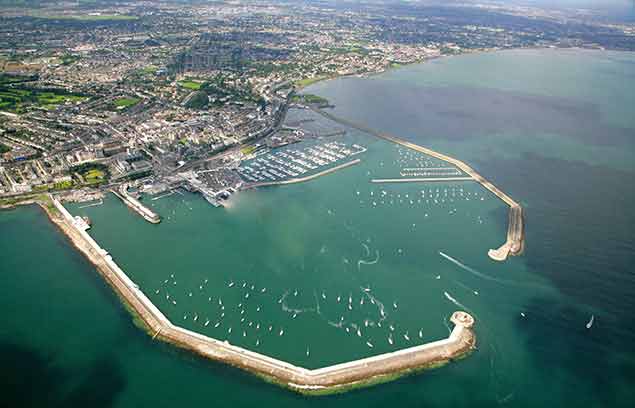 Dun Laoghaire Harbour as it is at present, offering ample space for finishing races. Photo Peter Barrow
Dun Laoghaire Harbour as it is at present, offering ample space for finishing races. Photo Peter Barrow
In the circumstances, surely this is a golden opportunity for the organisers of the Volvo Dun Laoghaire Regatta 2017 to take a look at any section of their enormous and very varied entry list, and select classes which could be given the treat of having at least one of their races finish within the harbour?
Increased ferry traffic was just one of the reasons why the racing for larger craft was obliged to take place outside the harbour. For national and international events, the obsession with committee boat starts and finishes further dictated the move seaward. In Dun Laoghaire, it meant that the connection between the town and active highly-visible sailing became more tenuous than ever.
Yet if we look back to old photos of Dun Laoghaire when it was in the full pomp of its years of Kingstown yachting glory, it was the action in the harbour which brought the whole show to life, and gave everyone a sense of involvement. So let’s hope that the powers-that-be realize that the deferring – permanently we hope – of the proposed liner berth offers an opportunity. Liners Out, Sailboats Back In – that could be the slogan for 2017.
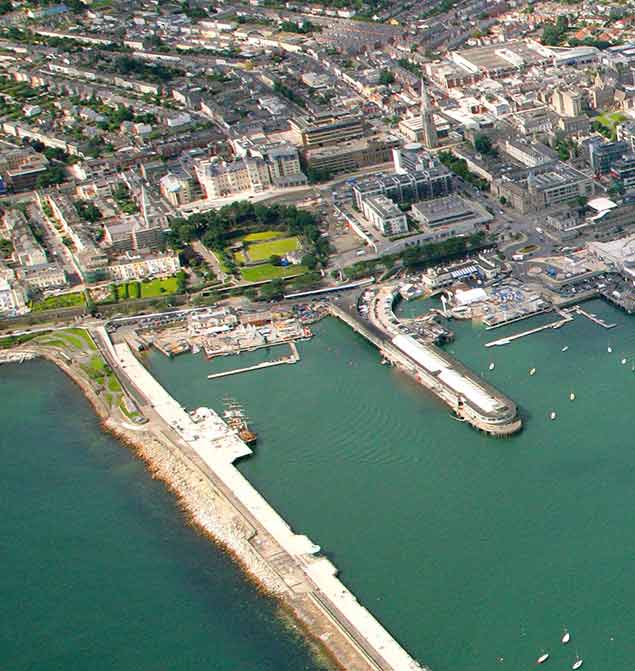 The accessible area off the National YC (photo pre-Lexicon) will provide berthing for Classics and Traditional craft Photo: Peter Barrow
The accessible area off the National YC (photo pre-Lexicon) will provide berthing for Classics and Traditional craft Photo: Peter Barrow
Of course we don’t expect that the really hot classes will agree to finish in-harbour. But there’s something about the Volvo Dun Laoghaire Regatta which attracts a significant segment of participants for whom a bit of fun is central to the sport, and indeed there are many who think that the real sport would be in having to make an in-harbour finish.
The Classics and Traditional Craft will be playing a significant role in this special year. In addition to a dedicated berth with lots of pontoon length being provided for them in the area off the National Yacht Club, the word is that on one day at least, they will have their start in the harbour, highly visible from the East Pier in the area immediately beyond the Carlisle Pier.
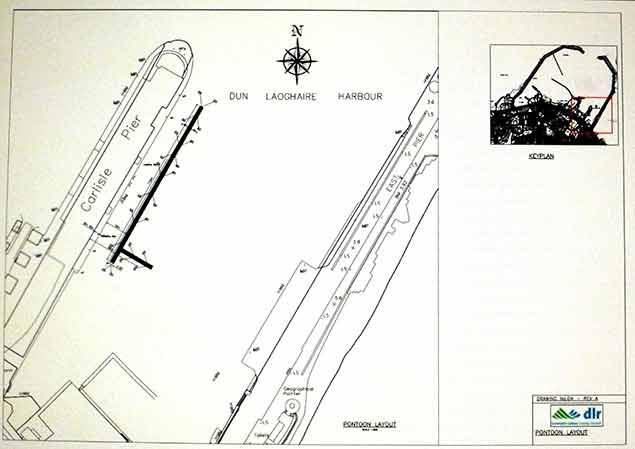 Plan of the proposed pontoon location off the National YC to berth “boats with bowsprits”.
Plan of the proposed pontoon location off the National YC to berth “boats with bowsprits”.
With boat types such as Drascombes coming as a fleet, the notion of the potential accessibility of sailing could be given an enormous boost. What could seem more approachable than the presence of Drascombe man Jack O’Keefe and his mates in friendly competition within the harbour, along with all sorts of other exotic craft such as the Shannon One Designs?
 Jack O’Keeffe’s Drascombe is usually seen in distant ports of the west… .Photo: Pierce Purcell
Jack O’Keeffe’s Drascombe is usually seen in distant ports of the west… .Photo: Pierce Purcell
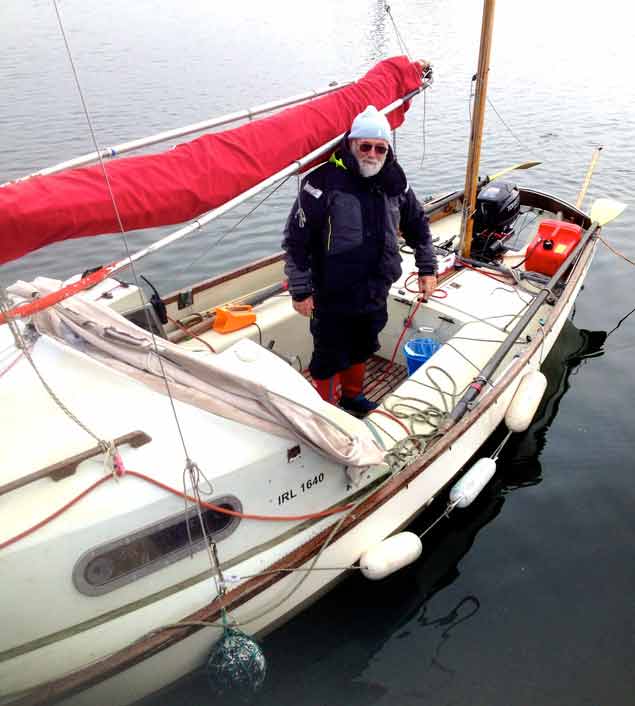 ….but in July 2017 he and his fellow enthusiasts are headed for Dun Laoghaire’s Bicentenary. Photo: Pierce PurcellNot least of such exotica will be the Water Wags, more than ever a part of Dun Laoghaire sailing and Dun Laoghaire Harbour. At this week’s launching of Volvo Dun Laoghaire Regatta ing of Volvo Dun Laoghaire Regatta 2017 in the National Maritime Museum, there was something very touching about the way that the only surviving boat of the original Water Wag class of 1887, the world’s first One Design, had been moved to the centre of the former Mariners Church. The little boat was there in pride of place as the great and the good of Irish sailing networked with each other as plans were revealed of the remarkable amount of behind-the-scenes work that goes into ensuring that this largest of all Irish sailing events runs smoothly.
….but in July 2017 he and his fellow enthusiasts are headed for Dun Laoghaire’s Bicentenary. Photo: Pierce PurcellNot least of such exotica will be the Water Wags, more than ever a part of Dun Laoghaire sailing and Dun Laoghaire Harbour. At this week’s launching of Volvo Dun Laoghaire Regatta ing of Volvo Dun Laoghaire Regatta 2017 in the National Maritime Museum, there was something very touching about the way that the only surviving boat of the original Water Wag class of 1887, the world’s first One Design, had been moved to the centre of the former Mariners Church. The little boat was there in pride of place as the great and the good of Irish sailing networked with each other as plans were revealed of the remarkable amount of behind-the-scenes work that goes into ensuring that this largest of all Irish sailing events runs smoothly.
In the 1890s, there must more than a hundred of these little boats in and around the Greater Dublin area. Even Erskine Childers, with part of the summer of 1894 unfilled in his plans, arranged to have one carted up into the Wicklow Hills to the mountain lake of Lough Dan near the house of his mother’s family, so that he could go sailing when the mood took him.
Yet with the new larger boats introduced in 1900, the little old double-enders just faded away. Fortunately, someone noticed that an odd-looking little canoe-sterned dinghy with a centreplate case on the beach at Malahide was one of the original Water Wags. She was being used for the occasional fishing trip, and it had been a long time since the centreplate had been used for sailing.
She was saved in the nick of time, and is now kept fully rigged in the Maritime Museum. But as the Wag Class historian Vincent Delany assured me at the Volvo reception, she really is absolutely the only surviving original example of a boat which was once so numerous, and fundamental to the global development of sailing.
 The original Water Wags of 1887, the world’s first One Design class. Despite being numerous in the 1890s, the original boat on display in the National Maritime Museum in Dun Laoghaire is now thought to be the only survivor of this historic type.
The original Water Wags of 1887, the world’s first One Design class. Despite being numerous in the 1890s, the original boat on display in the National Maritime Museum in Dun Laoghaire is now thought to be the only survivor of this historic type.
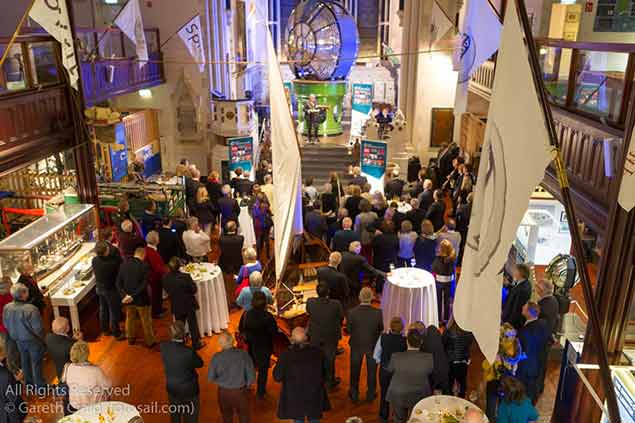 At the heart of things. The sole surviving Dublin Bay Water Wag of 1887 in the midst of the Volvo Dun Laoghaire Regatta 2017 launch reception in the National Maritime Museum on Wednesday night.
At the heart of things. The sole surviving Dublin Bay Water Wag of 1887 in the midst of the Volvo Dun Laoghaire Regatta 2017 launch reception in the National Maritime Museum on Wednesday night.
Volvo Dun Laoghaire Regatta will be among the biggest sporting participation events in Ireland in July, eclipsed only by the city marathons, when a massive fleet of over 400 boats sets sail from Dun Laoghaire Harbour. As Afloat.ie previously reported, the massive regatta was launched in the town's Maritime Museum last night with representatives of all 22 sailng classes involved.
Over 2,500 sailors will race from the four Dun Laoghaire waterfront yacht clubs (the Dun Laoghaire Motor Yacht Club (DMYC), the National Yacht Club (NYC), the Royal Irish Yacht Club (RIYC) and the Royal St George Yacht Club (RSGYC). Already over 230 yachts are entered and coming from all four coasts of Ireland and from England, Scotland, Wales, Northern Ireland and the Isle of Man, and more locally from all the four Dun Laoghaire based yacht clubs.
Speaking at the launch event, David Lovegrove, President, Irish Sailing Association (ISA) said “The VDLR is now firmly established in Ireland’s major sporting calendar and is the biggest participant sporting event in the country, after the city marathons. We are also proud that the VDLR continues to grow and build upon Ireland's international reputation as a quality sports and sailing destination and cements Ireland's reputation as a location for a major international regatta. In addition, local area businesses will benefit considerably from the influx of visitors as they enjoy the superb sailing action in Dublin Bay and a fantastic array of family oriented activities that have been set up on shore.”


























